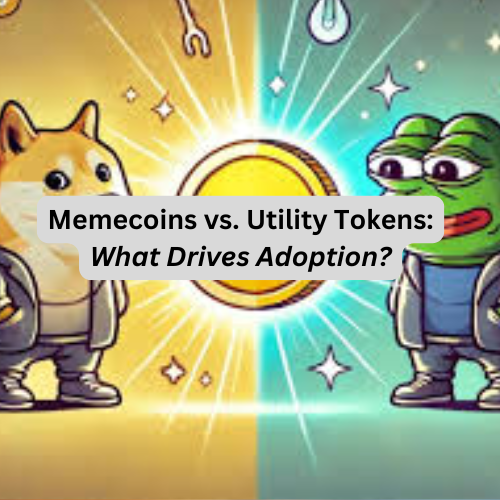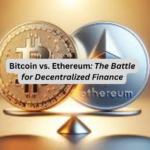
Memecoins vs. Utility Tokens: What Drives Adoption?
Memecoins like Dogecoin and Shiba Inu continue to dominate headlines, turning early adopters into millionaires seemingly overnight. On the other hand, utility tokens like Ethereum and Chainlink focus on powering real-world applications, building ecosystems that solve tangible problems.
So, why do memecoins often overshadow utility tokens in adoption trends? Can utility tokens compete with memecoins’ virality, or are they playing an entirely different game? Let’s explore the forces driving adoption, highlight examples of tokens bridging the gap, and unpack the risks and rewards of investing in either category.
1. Memecoins: Hype-Driven Adoption
Why Memecoins Dominate Headlines
Memecoins are built on community-driven hype and viral marketing, creating a frenzy that captures the attention of both crypto veterans and newcomers.
- Low Entry Cost: Memecoins often start with extremely low prices, making them accessible to everyday investors.
- Social Media Amplification: Platforms like Twitter, TikTok, and Reddit fuel memecoin popularity, with influencers and viral memes driving momentum.
- Promise of Quick Gains: The allure of turning a few dollars into life-changing wealth attracts speculative investors.
Key Memecoin Success Stories
- Dogecoin (DOGE):
- Started as a joke but gained mainstream traction with endorsements from Elon Musk and adoption for tipping and payments.
- Shiba Inu (SHIB):
- Dubbed the “Dogecoin killer,” Shiba Inu expanded its ecosystem with a decentralized exchange (ShibaSwap) and NFT projects.
- Pepe (PEPE):
- Based on the Pepe the Frog meme, this memecoin capitalized on cultural relevance to generate massive short-term hype.
Memecoins thrive because they are fun, accessible, and culturally engaging. But their success is often fleeting, and the lack of inherent utility can lead to massive price volatility.
2. Utility Tokens: Building Long-Term Value
What Are Utility Tokens?
Utility tokens serve specific purposes within a blockchain ecosystem, offering real-world applications like accessing services, paying fees, or staking.
Examples:
- Ethereum (ETH): Powers the Ethereum network, enabling smart contracts, decentralized apps (dApps), and NFTs.
- Chainlink (LINK): Provides real-world data to smart contracts, bridging the gap between blockchain and external systems.
Why Utility Tokens Matter
Utility tokens focus on solving real-world problems, creating value through use cases rather than speculation.
- Ecosystem Growth: Their adoption drives the success of decentralized finance (DeFi), gaming, and supply chain applications.
- Resilience: Utility tokens are less susceptible to the short-term hype cycles that define memecoins.
3. Bridging the Gap: Memecoins with Utility
Some memecoins are evolving beyond hype by adding utility, blurring the lines between meme-driven virality and real-world use cases.
Dogecoin’s Utility Shift
- Initially created as a joke, Dogecoin is now accepted as payment by major companies like Tesla and AMC Theatres.
- Its use in tipping and microtransactions has given it a functional edge over other memecoins.
Shiba Inu’s Ecosystem Expansion
- The launch of ShibaSwap and Shiba’s foray into NFTs have added layers of utility, helping sustain its relevance beyond speculation.
A New Trend?
Memecoins incorporating utility stand a better chance of long-term survival, appealing to both speculative investors and those seeking tangible use cases.
4. Risks and Rewards: Investing in the Hype
Risks of Memecoins:
- Volatility: Prices often swing wildly based on social media hype, making them risky for long-term investors.
- Rug Pulls: Many memecoins lack transparency, leaving investors vulnerable to scams.
- Lack of Utility: Without real-world use cases, memecoins often rely solely on community interest to maintain value.
Rewards of Memecoins:
- High ROI Potential: Early adopters can see exponential gains if a memecoin gains mainstream attention.
- Low Entry Costs: Investors can gain exposure to memecoins with minimal upfront capital.
Risks of Utility Tokens:
- Slower Growth: Utility tokens often lack the viral momentum of memecoins, leading to slower price appreciation.
- Regulatory Challenges: As functional assets, utility tokens are more likely to face regulatory scrutiny.
Rewards of Utility Tokens:
- Sustainability: Real-world use cases and developer adoption ensure long-term growth potential.
- Lower Speculation Risk: Utility tokens are generally less affected by short-term hype cycles.
5. CryptoLiveLeak’s Tips for Creating a Viral Memecoin Campaign
Platforms like CryptoLiveLeak are key players in helping memecoins gain traction while ensuring authenticity and sustainability.
How to Create a Viral Memecoin Campaign:
- Build a Strong Community:
- Engage with audiences on platforms like Discord, Reddit, and Twitter.
- Create a relatable backstory or theme to connect emotionally with your audience.
- Leverage Influencers:
- Partner with influencers to amplify your coin’s visibility and reach.
- Integrate Utility:
- Even basic functionalities like staking or payments can help memecoins stand out.
- Transparency Is Key:
- Publish a clear whitepaper and roadmap to gain investor trust.
- Add Fun and Humor:
- Memecoins thrive on relatability, so keep the tone light and engaging.
How CryptoLiveLeak Helps:
- Marketing Expertise: Tailored campaigns designed to make your memecoin viral.
- Community Building: Tools to foster authentic, engaged communities.
- Educational Content: Helping investors understand the risks and opportunities in the memecoin space.
6. Can Utility Tokens Compete with Memecoins?
Utility tokens and memecoins serve different purposes, but their paths are increasingly converging:
- Memecoins with utility (e.g., Dogecoin’s payment integrations) offer a bridge between hype and function.
- Utility tokens that incorporate viral marketing tactics can attract broader audiences.
The future of adoption may not be about choosing one over the other but combining the best of both worlds.
Conclusion: Memecoins and Utility Tokens in Perspective
The battle between memecoins and utility tokens isn’t about one being better than the other—it’s about understanding their unique strengths and risks. Memecoins thrive on virality and cultural relevance, while utility tokens build long-term value through real-world use cases.
Whether you’re investing in a memecoin or a utility token, due diligence is key. Platforms like CryptoLiveLeak are invaluable for navigating this dynamic market, helping projects launch successfully while providing investors with the tools to make informed decisions.
So, which side are you on—memecoins or utility tokens? Or do you believe in bridging the gap?
FAQs
1. What’s the difference between memecoins and utility tokens?
Memecoins rely on community-driven hype and social media virality, while utility tokens have real-world use cases and power blockchain ecosystems.
2. Can memecoins have utility?
Yes, some memecoins like Dogecoin and Shiba Inu are evolving by adding utility, such as payment integrations and NFT platforms.
3. Are memecoins a good investment?
Memecoins can offer high returns, but they are highly volatile and carry significant risks, including rug pulls and lack of long-term utility.
4. How does CryptoLiveLeak help memecoins and utility tokens?
CryptoLiveLeak provides marketing, community-building, and educational resources to support project launches and build trust with investors.
5. How can utility tokens attract more adoption?
Utility tokens can benefit from incorporating viral marketing strategies and focusing on user-friendly applications to bridge the gap with memecoins.
For more insights into the crypto world, visit CryptoLiveLeak.org!
















